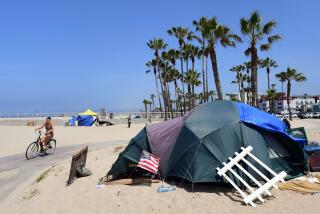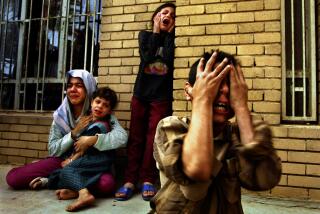In Mosul, Insurgents Have Become Road Warriors
MOSUL, Iraq — Army hatch gunner Brandon Jones may have missed the man who fired potshots at his head Saturday, but the sergeant managed to destroy a dangerous tool: the insurgent’s car.
As U.S. and Iraqi forces have battled guerrillas for control of the northern city of Mosul in recent weeks, the insurgents have been putting their wheels to work.
Instead of packing their vehicles with explosives and detonating them in suicidal attacks, insurgents are more likely to fire on troops as they speed past their patrols and combat outposts.
Soldiers say the insurgents seem to favor Opels, because they have a reputation for being fast. Cars are also becoming insurgents’ preferred hiding place for weapons.
“What’s happening is, they realize we’re finding the weapons they try to bury and hide in warehouses,” said Lt. Col. Michael E. Kurilla, commander of the 1st Battalion, 24th Infantry Regiment of the 25th Infantry Division, the Army unit responsible for Mosul’s crowded west side.
“What they’re doing now is hiding all of their weapons in cars,” Kurilla said. “That way they can keep it moving around and out of sight.”
Sometimes U.S. soldiers pursue the drive-by shooters in 21-ton Stryker armored vehicles, jumping curbs and barreling down rutted dirt roads.
Such was the case Saturday, when Jones, 23, of Santa Rosa, and the rest of Bravo Company, 2nd Platoon, were fired at by suspected insurgents in at least two vehicles.
The day began quietly enough, with 1st Lt. David Webb, 23, of Hawaii, leading the men in a short prayer before they climbed into their armored vehicles.
Among other things, Webb asked for protection during their mission.
“Lord, if we do come into contact, make our weapons systems deadly,” Webb said in his prayer.
The unit then set out to man a traffic checkpoint in northwest Mosul, an area of heavy insurgent activity.
After a few minutes of inspecting car trunks and questioning drivers, Webb received word that insurgents were firing rocket-propelled grenades and mortars at a nearby government building. They were escaping in two cars, white and blue, he was told.
Webb and the commander of another Stryker quickly spotted the vehicles speeding through the warren of narrow streets. They gunned their engines and the chase began.
As Webb’s Stryker sought to overtake the suspected insurgents, the second Stryker closed in behind and prepared to fire its .50-caliber machine gun. But before that could happen, the second Stryker suddenly ground to a halt with a broken axle.
“We’re stuck. We can’t move,” the commander radioed to Webb.
Meanwhile, Webb’s armored vehicle had lost sight of the insurgents. As they scanned the area, Jones and the lieutenant heard the snapping of bullets nearby.
Suddenly the two insurgent cars came flying down an alley and almost slammed into the side of Webb’s Stryker before screeching to a halt.
“Kill those guys!” Webb yelled from his perch at the front of the vehicle.
Standing in a rear hatchway, Jones swiveled to see the insurgents throwing open their doors and running.
For a moment, Jones said he looked into the face of one of the men and saw eyes wide with fear. Clean-shaven and appearing to be in his 30s, the insurgent clutched an AK-47 assault rifle in his right hand.
Jones pulled the trigger on his rifle, repeatedly.
“I dumped a whole magazine at him before we moved behind a wall and I couldn’t see him anymore,” he said.
Webb told the driver to shift into reverse, but by the time Jones had a clear view of the alley, the man was gone. Hoping the vehicles might still contain insurgents, Jones fired. One of them burst into flames.
The flames touched off a chain reaction, detonating rocket-propelled grenades and hundreds of rounds of ammunition in the trunk.
Soldiers in Jones’ squad, who had exited their Stryker to pursue the suspects on foot, sought cover in a nearby home. A burning car door was thrown into the air and landed on a nearby roof.
After the turmoil subsided, soldiers inspected the other car. They found a sniper rifle, a heavy machine gun, a handful of grenades, a rocket-propelled grenade launcher, walkie-talkies, batteries and boxes of bullets. They also recovered several cellphones, one of which began ringing as soldiers examined it.
“Don’t answer it. We don’t want them to know we have it,” one soldier said.
The incident was the platoon’s first close-up experience with insurgents.
“Usually you get shot at and never see who’s doing it,” Jones said. “Either that or we get hit by [homemade bombs] and stuff that you can’t react to. This was different.”
Even though they didn’t find or kill the insurgents, Jones said he and his fellow soldiers had made a point.
“We got a couple of their cars,” Jones said. “Maybe that will keep them off the street for a while.”
More to Read
Sign up for Essential California
The most important California stories and recommendations in your inbox every morning.
You may occasionally receive promotional content from the Los Angeles Times.










